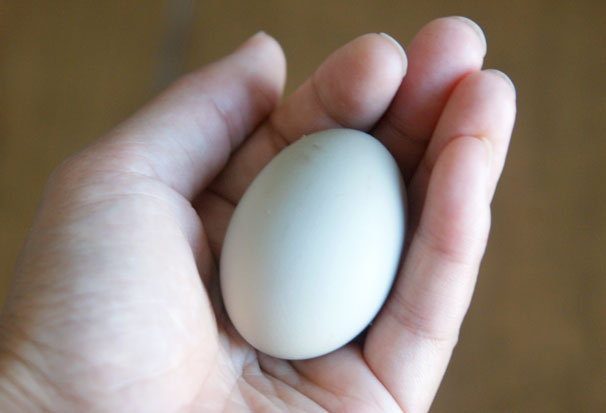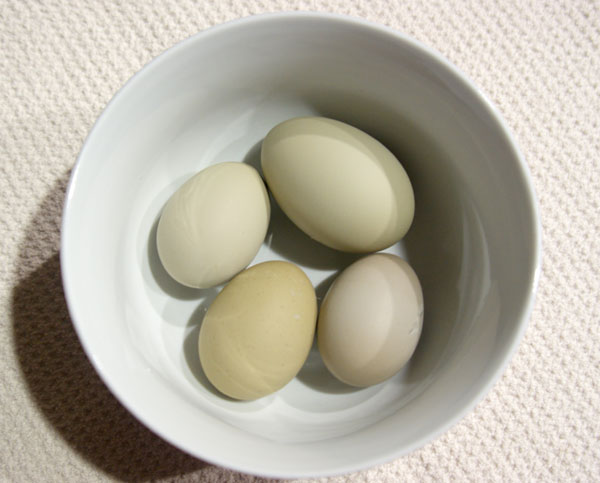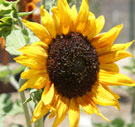The Eggs Have Landed! Plus Tips For Storing Home Grown Eggs
July 13th, 2012
Previously, I had written about our chickens, explaining that they would be laying eggs in the next month or two. Well, it has happened sooner than expected and exactly one week ago today, the first egg landed in the nesting box!
Needless to say I was very excited!!! And proud that the “girls” worked out where to lay all by themselves.

I can’t say for sure which chicken lay the first egg, I’m guessing it is one of the silver-laced wyandottes. When my youngest step-daughter saw it she said it was the most beautiful egg she has ever seen…I would have to agree with her :)
The chicken laying call is so very distinct and LOUD, a succession of bok-bok-bok-bok-BAAAAWK!’s that sound amusing to us and painful for the chicken. I have read that the first eggs a chicken lays are smaller and as they mature they will get larger. Below you can see the size comparison of a store bought commercial egg on the left and our first home grown egg on the right.

We are averaging an egg a day at the moment and over time I am guessing we will average maybe 3-4 eggs a day between our 5 chickens. They need at least 14 hours of daylight (whether natural or artificial) to lay eggs, so during the winter months there will be less eggs. I think all the girls have laid at least one egg by now. In the picture below, the biggest egg that you see in the bowl actually had a double yolk inside. I feel sorry for our poor little chickie who had to lay that one! Sure was yummy though!

Tips for Storing Home Grown Eggs:
Don’t wash your eggs! When chickens lay an egg, they lay it with a natural barrier around it – known as a “bloom” – that protects the shell from bacteria. Washing will remove that antibacterial coating.
However, sometimes eggs will get dirt or poop on them, in which case it’s a good idea to wipe it clean with a dry cloth or if need be wash the eggs under the tap with warm running water. Because the “bloom” has been removed with washing, you can sanitize them by spraying them using bleach diluted in water as a spray mixture. Let the eggs to dry on a rack or in a basket.
Never immerse the eggs in water, especially in cold water as cold water will actually cause the pores in the eggshell to pull bacteria from the surface in through the shell and into the egg.
Once eggs are clean and dry, store them in egg cartons with the pointy end down. Why? Because the air cell/sack/pocket that is in the egg is at the rounded end. When this end remains upward the egg retains moisture. It also keeps the yolk centered in the whites and reduces breakage.
Label the carton with the date of collection and put them in the refrigerator. You don’t have to put eggs in the refrigerator, but they will last longer this way. Eggs are good for one month after the date of collection when stored in the fridge, and oftentimes can remain good for longer than that.
Use the float test to check egg freshness: fill a bowl or glass with water and place an egg in it. An egg that floats has too big an air pocket inside the shell which means the contents have evaporated too much and it has most likely gone bad.
 From Little Things, Big Things Grow
From Little Things, Big Things Grow Our Brown Eyed Golden Girl
Our Brown Eyed Golden Girl Patchwork Bedspreads
Patchwork Bedspreads Visit to the Riverside Art Museum
Visit to the Riverside Art Museum

